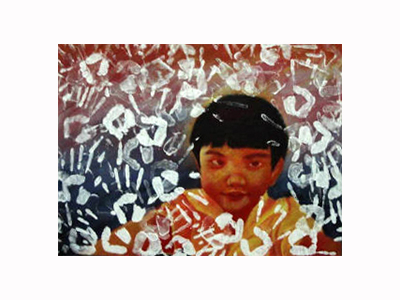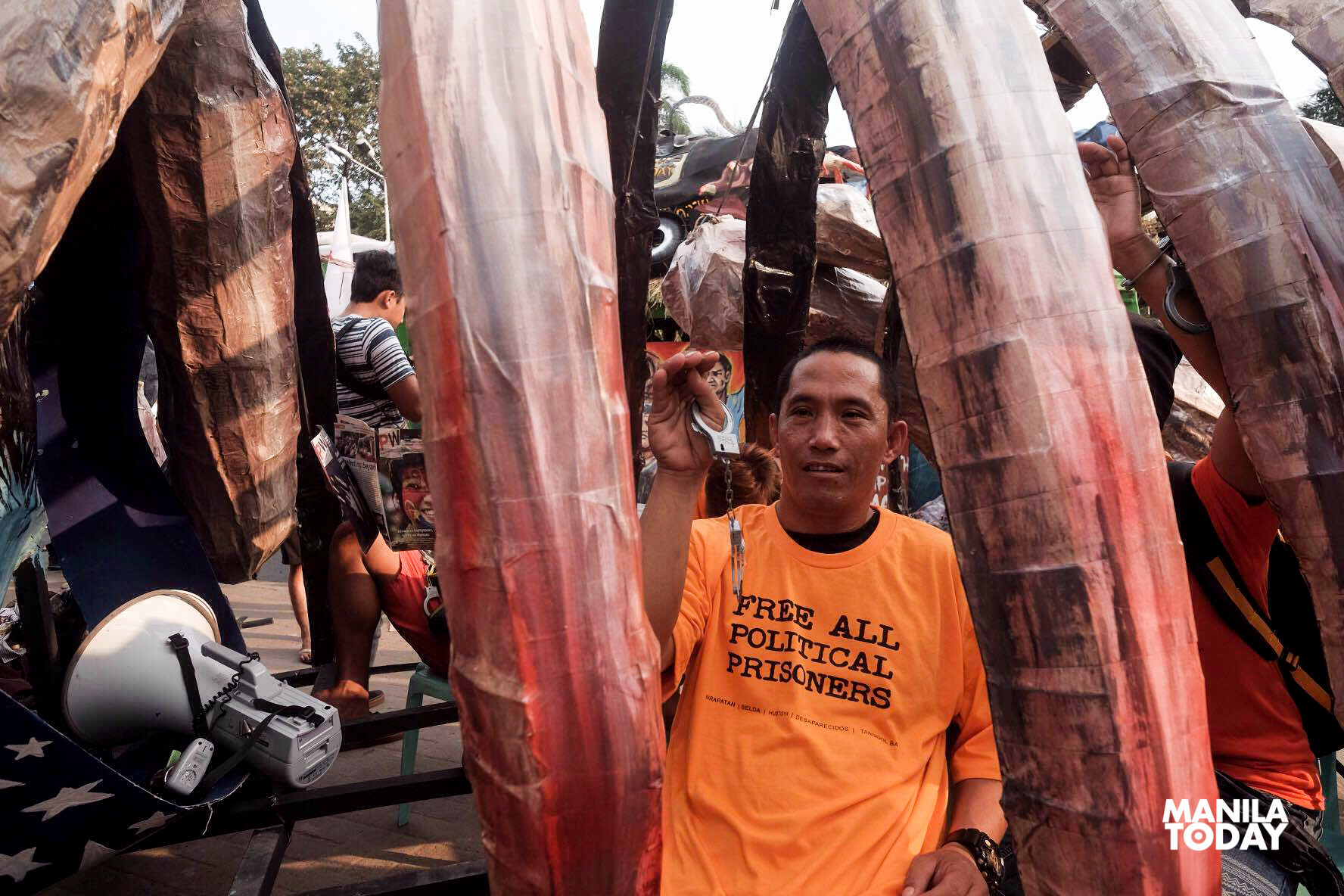Hindi pinalampas ng mga manggagawa ang isyu ng pagpapalibing sa yumaong diktador Ferdinand Marcos, Sr. sa Libingan ng mga Bayani at ang tangkang paglilibing din sa pananamantala at pangbubusabos ng kanyang rehimen.
Bukod pa sa pagpataw ng Batas Militar at mga kasong paglabag ng karapatang pantao ng dating Pangulong Marcos, pinasa at pinirmahan niya ang mga batas na lalong nagpahirap sa mga manggagawa sa bansa.

Ang mga pamana ni Marcos ang nagsisilbing ilan sa mga malalaking rason kung bakit kailangang ipagpatuloy ng mga manggagawa ang kanilang laban sa buong bansa. Bitbit sa hanay ng mga obrero noong Nobyembre 30, Araw ni Andres Bonifacio, na ginugunita na rin ng mga grupo na Araw ng Anakpawis, ang panawagang pagkundena sa paghirang kay Marcos bilang bayani ng mga Pilipino.
Pandarahas sa mga unyonista
“Tapos na daw ang Martial Law, ngunit bakit sa loob ng engklabo tuloy at nagpapatuloy ito!” sabi ni Michael Hinggan, isang manggagawa sa Dong Yun Plate Making Corporation na nagimprenta ng pambalot sa produktong pangkomersyo.
Ang export processing zones (EPZ) ay isang porma ng engklabo na hindi nasasakupan ng mga alituntuning pang-ekonomiya sa bansa. Ito ay itinatayo sa mga developing countries kung saan nananaig ang mga foreign companies sa mga engklabo. Ang mga ginagawang produkto ay sadyang inilalabas o ineexport sa ibang bansa at dahil dito binibigyang luwag sa aspeto ng tariff at quota ang mga foreign investors.

Sa panahon ni Marcos, itinayo ang unang EPZ sa Bataan. Ito ay sa layuning iengganyo ang mga dayuhan na mamuhunan sa Pilipinas.
Sa kasalukuyan, dumami ang pagtatayo ng EPZ sa iba’t ibang parte ng bansa. Ang Philippine Dong Yun ay isa sa mga kumpanya sa loob ng engklabong Filinvest Technological Park sa Calamba, Laguna.
“Alam naman natin na sa loob ng engklabo ay mayroong patakarang ipinapatupad na sinasagka ang batas ng Pilipinas. Narito ang policy nila na ‘no union, no strike policy’. Ngunit lahat ng ito ay aming sinagkaan at nakapagtayo kami ng isang tunay na unyon,” sabi ni Hinggan na siya ring pangalawang taga-pangulo ng Samahan at Ugnayan ng mga Manggagawa sa Philippine Dong Yunsa ilalim ng National Federation of Labor Unions ng Kilusang Mayo Uno (SUMAPHI-DY-NAFLU-KMU).
Binuo ng mga manggagawa ng Dong Yun ang SUMAPHI-DY dahil sa lubhang pananamantala ng kumpanya. Ayon sa ulat ng Kilusang Mayo Uno (KMU), ito ang mga paglabag ng kumpanya:
- Pasahod na bababa pa sa subsistence wages (Php 180 – Php 336)
- Pwersahang overtime
- Hindi pagremita ng Social Security System (SSS) at PhilHealth na nagdulot ng kawalang benipisyo sa mga manggagawa
- Hindi pag-apruba ng sick leave kahit may medical certificates
- Walang safety gear kaya nakakalanghap ng cancerous chemicals
- Walang company clinic
- Agarang pagtanggal kapag napahamak sa pagawaan

Nanalo ang SUMAPHI-DY sa eleksyon bilang sole and exclusive bargaining agent (SEBA) ng pagawaan noong Setyembre 2015. Kahit may sertipikasyon na mula sa Department of Labor and Employment (DOLE), tinibag pa rin ang kanilang unyon, tinanggihan ang collective bargaining agreement (CBA) at iligal na pinatanggal ang 22 opisyales at miyembro ng unyon ng Human Resource manager na si Devie Requilman.

Liban pa rito, marahas ding binuwag ng mga goons ng kumpanya ang kanilang piketlayn noong Nobyembre 7.
Inumpisahan ni Marcos ang kontraktwalisasyon
Mayroon nang insinasakatuparang porma ng kontraktwalisasyon sa ilalim ng administrasyon ni Ferdinand Marcos.
Nang idineklara ang Batas Militar, binasag ang panandaliang katahimikan ng welga ng manggagawa sa La Toñdena Distillers Incorporated – kasalukuyang kilala sa pangalang Ginebra San Miguel Incorporated – para gawing regular ang lagpas anim na buwang nagtratrabahong mga “casual” o kontraktwal at “extra” o pana-panahong manggagawa.
“Kahalintulad ng aming kumpanya, ang Wyeth, kung saan ito ay nabili ng Nestlé. Sa amin pong hanay, umabot nang 18 taon na kontraktwal ang mga manggagawa. Ganun po katindi. Iyon pong sinasabing pangunahin [ang kumpanya na] gumagawa ng gatas ng bata pero yung manggagawa nito ay siil ng karapatan pati sa sahod,” inilahad ni Mar Almario, miyembro ng Samahan ng manggagawang kontraktwal (SAMA-AKO) sa Wyeth.

Anim na buwan matapos bilhin ng Nestlé and Wyeth, itinanggal sa trabaho ang 87 na mga manggagawa. Mula noon ay idinulog nila ang kanilang pagbabalik-trabaho sa National Labor Relations Commission – Calamba Office at nagprotesta sa harap ng planta sa Makati. Nanalo sila sa kanilang laban sa Court of Appeals at simula noon ay itinayo nila ang Wyeth 87.
Ayon sa pinakabagong datos ng Kilusang Mayo Uno-Metro Manila, umabot na sa 80% ang mga manggagawang kontraktwal.
Nilahad ng tagapagsalita ng Alyansa ng mga Manggagagawa Laban sa Kontraktwalisasyon (ALMAKON) na si Renato Robles na may iba’t ibang mukha ang kontraktwalisasyon. Ilan dito ay ang outsourcing, casual, apprentice, job order, seasonal workers, at project-based na pare-parehas lang ang nagiging kalagayan ng manggagawa.

Binuo ng 300 na manggagawa ang ALMAKON nitong Setyembre 25 upang makiisa sa laban sa kontraktwalisasyon.
Paglaban sa nagpapatuloy na mga anti-manggagawang polisiya
Noong Eleksyon 2016, naging malaking kampanya ng mga kandidato ng pagkapangulo ng bansa ang pagpuputol ng “endo” o end of contract – na nangangahulugang pagtatapos ng anim na buwang pagtatrabaho ng manggagawa sa pagawaan at mag-aaplay ulit ng anim na buwan para magpatuloy sa pagtratrabaho.
Si Pangulong Rodrigo Duterte ang pangunahing nagsumbat at sinabi sa isang presidential debate na, “Endo must stop!”
Makalipas naman ang kanyang unang anim ng buwan sa panunungkulan, patuloy pa rin ang kontraktuwalisasyon sa bansa. Hindi pa rin naipapatupad ang proklamasyon ng pagbabasura nito – kasama ang pagpapatuloy ng “no union, no strike policy” at mas mababang pa sa subsistence wage na pasweldo.

“Naninindigan kami na dapat talikuran ni Pangulong Duterte itong Marcosian policies at kung may dapat maging huwaran, dapat maging halimbawa niya si Andres Bonifacio,” ani ni Bong Labog, tagapangulo ng KMU.
Gaya ng diwang rebolusyonaryo ni Andres Bonifacio, naninindigan ang mga manggagawa na marapat lang labanan ang pangongontrol ng ibang bansa para makalaya ang mga manggagawa sa pagkatali sa mga neoliberal na polisiyang nananamantala sa mga manggagawa.

“Mga kababayan, malinaw na hanggang sa kasalukuyan, walang pundamental na pagbabago sa ating bansa mula sa kolonyalistang Espanyol hanggang sa kasalukuyan […] Nananatili ang pulitikal na kontrol ng imperyalistong Estados Unidos, nananatili ang militar sa kontrol ng Estados Unidos sa rehimeng ni Duterte,” sabi ni Jerome Adonis, tagapagsalita ng KMU.
Sinusulong din ng mga progresibong grupo ng mga manggagawa na dapat isagawa ni Pangulong Duterte ang mga proklamasyong pagputol ng hindi pantay na tratado sa Estados Unidos dahil ang mga kasunduang ito ang lalong nagpapalugmok sa mga manggagawa at kanilang pamilya sa kahirapan.

“Kasama sa laban ang lahat ng uring manggagawa sa Laguna at sa iba pang lugar dito sa Maynila. Kaming mga mangagawa ay hindi titigil hangga’t hindi nakakamit ang tagumpay!” badya ni Hinggan.
The post Pamana ni Marcos: pahirap sa manggagawa appeared first on Manila Today.






















































































